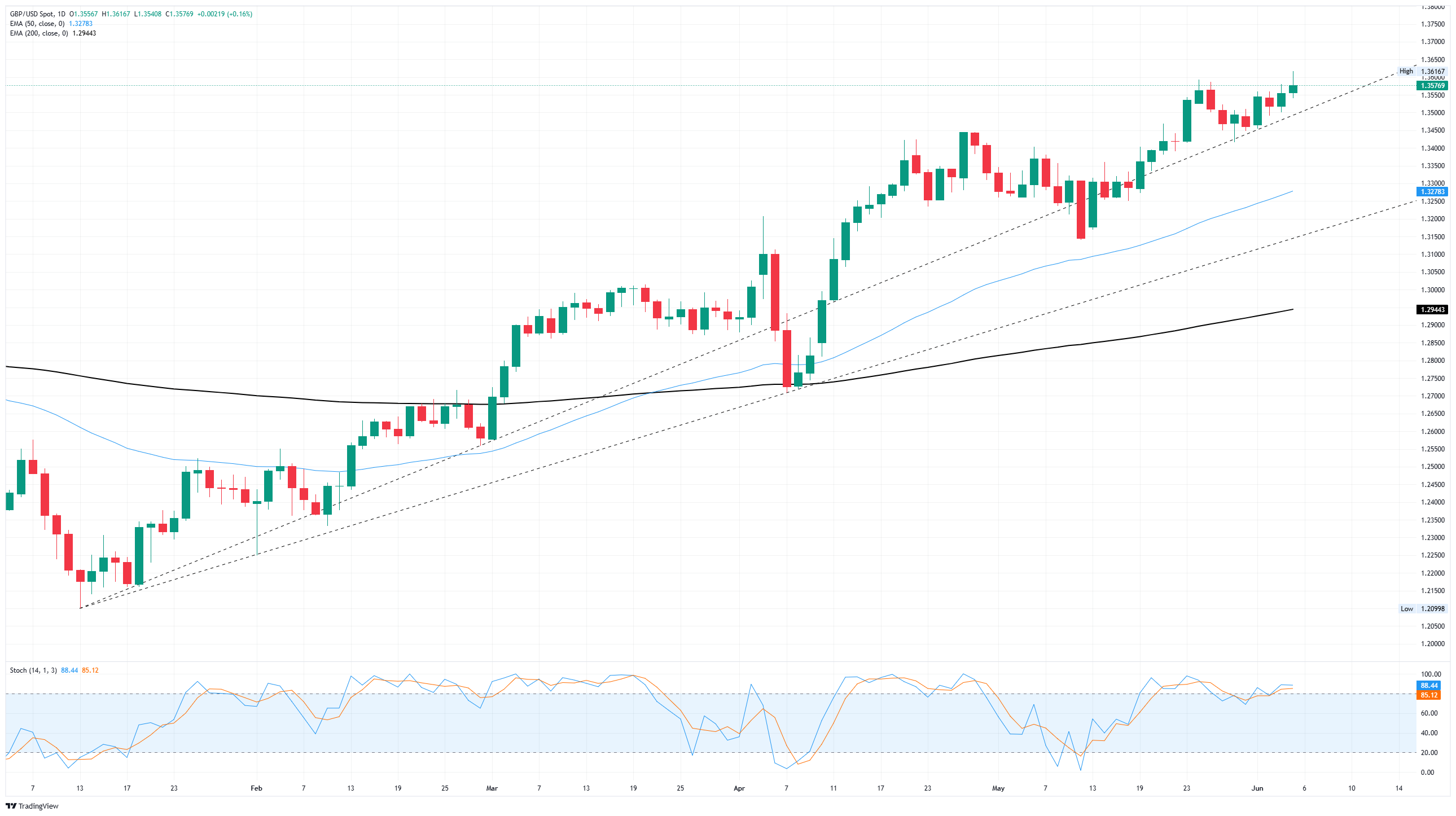GBP/USD continues to find fresh highs as Greenback withers
- GBP/USD tested above 1.3600 for the first time in almost four years.
- Pound Sterling gains march ahead unguarded as USD flows crumple.
- Markets sentiment is coiling ahead of key US NFP labor figures due on Friday.
GBP/USD tested its highest bids in over three years on Thursday, briefly climbing above the 1.3600 handle in intraday trading for the first time in 40 months. Bullish momentum remains tepid, however, with investor sentiment getting hobbled by approaching US Nonfarm Payrolls (NFP) jobs data due on Friday, as well as a rapidly-accelerating blowout between US President Donald Trump and his (now former) right-hand hatchet man Elon Musk.
Jobs are a key focus for investors this week. ADP job postings dropped in May, leading investors to adjust their expectations for the upcoming NFP report. May’s NFP data is projected to show a net gain of 130K jobs, down from last month’s 177K.
Elon Musk, former head of the Trump administration’s Department of Government Efficiency (DOGE), has been criticizing Trump’s ‘big beautiful budget bill’ on social media. Musk is upset that the budget lacks the federal spending cuts he implemented without Congressional approval at the start of Trump’s second term. Their relationship is deteriorating with ongoing exchanges on social platforms.
The Trump team is preparing for trade talks with China after a call between President Trump and Chinese President Xi Jinping. Trump described the call as productive, with tariff negotiations set to continue. However, Trump and his team historically struggle to stay composed with Chinese trade officials. They recently traded insults regarding alleged trade violations related to pre-deal terms agreed upon in Geneva earlier this month.
GBP/USD price forecast
Thursday’s fresh push into three-and-a-half-year highs leaves GBP/USD firmly buried deep in bull country; the pair is already on pace to close in the green for a fifth straight month, and is up over 12.5% bottom-to-top from January’s bottom bids near 1.2100.
GBP/USD daily chart

Pound Sterling FAQs
The Pound Sterling (GBP) is the oldest currency in the world (886 AD) and the official currency of the United Kingdom. It is the fourth most traded unit for foreign exchange (FX) in the world, accounting for 12% of all transactions, averaging $630 billion a day, according to 2022 data. Its key trading pairs are GBP/USD, also known as ‘Cable’, which accounts for 11% of FX, GBP/JPY, or the ‘Dragon’ as it is known by traders (3%), and EUR/GBP (2%). The Pound Sterling is issued by the Bank of England (BoE).
The single most important factor influencing the value of the Pound Sterling is monetary policy decided by the Bank of England. The BoE bases its decisions on whether it has achieved its primary goal of “price stability” – a steady inflation rate of around 2%. Its primary tool for achieving this is the adjustment of interest rates. When inflation is too high, the BoE will try to rein it in by raising interest rates, making it more expensive for people and businesses to access credit. This is generally positive for GBP, as higher interest rates make the UK a more attractive place for global investors to park their money. When inflation falls too low it is a sign economic growth is slowing. In this scenario, the BoE will consider lowering interest rates to cheapen credit so businesses will borrow more to invest in growth-generating projects.
Data releases gauge the health of the economy and can impact the value of the Pound Sterling. Indicators such as GDP, Manufacturing and Services PMIs, and employment can all influence the direction of the GBP. A strong economy is good for Sterling. Not only does it attract more foreign investment but it may encourage the BoE to put up interest rates, which will directly strengthen GBP. Otherwise, if economic data is weak, the Pound Sterling is likely to fall.
Another significant data release for the Pound Sterling is the Trade Balance. This indicator measures the difference between what a country earns from its exports and what it spends on imports over a given period. If a country produces highly sought-after exports, its currency will benefit purely from the extra demand created from foreign buyers seeking to purchase these goods. Therefore, a positive net Trade Balance strengthens a currency and vice versa for a negative balance.

